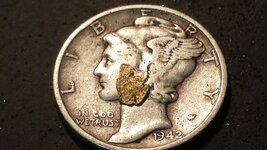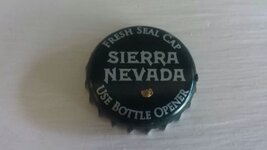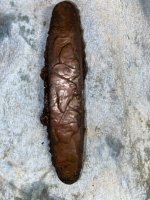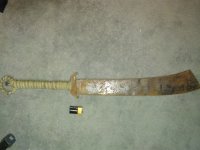goldenIrishman
Silver Member
- Feb 28, 2013
- 3,465
- 6,152
- Detector(s) used
- Fisher / Gold Bug AND the MK-VII eyeballs
- Primary Interest:
- Other
Once again I've been asked to explain how to do the Shake & Bake process to recover fine gold. I figured I'd go ahead and just start a thread on it for a couple of reasons. First off this will make it easier for the new guys to find it with a simple search and secondly it will also give us all a place to discuss ways of improving this process and tailoring it to the materials found in your location.
As many of you know, I'm located in S.E. Arizona which is known for a wide variety of minerals. Gold, Copper, Silver as well as many different types of crystals. When they refer to "Highly Mineralized" soil around here, they're not kidding. It's because of this high mineral content that a lot of the gold ends up having what we call "Desert Varnish" covering a lot of the micro/micron sized gold which makes it impossible to see. It may be large enough to see without magnification, but if it's covered with these varnish deposits you stand a very good chance of tossing it out because you just can't recognize it as gold.
This is where the Shake & Bake (S&B) method of processing comes in. It will remove that pesky coating from your gold so you can see it for what it is. This is an inexpensive and yet very efficient way to get more gold out of your materials. The actual process is not hard to do if you follow a few simple steps as outlined below.
1: Classify: Screen your black sand materials down to uniform sizes. I like to take them down to a 20 mesh to start with. This just makes sure you don't have any really big chunks in the mix. Anything that's is larger than 20 mesh you can crush up and re-screen later.
2: Crush: Take the sands and crush/grind them as fine as you can get them. This will help to loosen up some of the coating and in some cases will remove it entirely. I've tried several methods of doing this step and all of them worked to some degree. Mortar and pestle will work but is a lot of work even on small batches. An electric coffee grinder will also do the job but the blades on them wear out VERY quickly. I have settled in at this time to using my ore crushing tube but that's just until I can get my hands on a small ball mill to try out. The impacting of the materials will do a couple of things for you. First of course is that it will turn your materials into dust in short order. Second is that because gold is very malleable small pieces will get flattened out so you can spot them in the pan easier. Once you have the materials crushed down to around 100 mesh you are ready to move onto the next step.
3: HEAT: There are any number of ways to do this step but let me say right off that it should always be done OUTDOORS!!! In many areas of the country, mercury was used to process fine gold. Many of the old timers were not what we would call safety minded when it came to using mercury. It's not uncommon in areas like the gold rush country of California (as well as many other places) to find bits of gold that have mercury on them. Mercury vapor is NASTY STUFF and will cause you all kinds of health problems. It doesn't take much of it for it to damage you beyond a doctors ability to fix ya up. As a trained lab tech, I'm used to handling some pretty nasty stuff and I treat mercury with kid gloves. (Ok... Safety Nazi speech over for now)
The object of this step is to heat your materials up to as high a temperature as possible. The hotter the better!!! What ever heat source you decide on using, just make sure it can be safely used outside. Camp stoves, hot plates, old BBQ setups etc can all be used. Even those charcoal starter chimney things can be used very effectively. As far as a container to hold your materials in goes, anything that will be able to handle the temperature of your heat source will do. I've used old metal gold pans as well as cast iron skillets. Gold pans will allow your materials to heat up faster, but skillets have a handle on them which comes in handy at times. It's also a nice thing to have one of those infrared laser thermometers on hand to check the temp of your materials. Just about any temp over 450 degrees F will do. Also remember that there are other things in some areas that give off some nasty stuff when heated. It's always a good idea to stay well up wind while everything is getting hot.
4: Quenching: This is where the magic takes place. By heating the materials up we have caused them to expand. By quenching them in cold liquid we shrink them back to normal size at a very rapid rate. The coating on the gold can not handle this rapid contraction ans will crack off of the gold at this stage. On your quenching bath you have a couple of options to choose from. Both require ice to cool them off but have different ways of applying the ice which I'll explain in a moment. Your first option is to use good old ice water. Nothing fancy here at all. A coffee can or small bucket will work fine. Just throw in a trays worth of ice to get it as cold as possible and your set. Another option for your quenching bath is to mix salt and vinegar together. Vinegar is a mild acid and by mixing salt with it you produce Sodium acetate. ( I add salt until the vinegar will not dissolve any more of it) The mixing should be done outdoors as it will give off a very small amount of chlorine gas. As long as you stay upwind, keep small children and animals away from the area it's not enough gas to really worry about. But here is where method of chilling your bath changes. You don't want melting ice to dilute the sodium acetate mix so you need to place the ice into a zip-lock style plastic bag. It will take a little longer to chill the bath but you won't dilute it. you can also chill it by placing the container into a larger container that is filled with ice.
Now that you've got your quenching bath all set up and your materials are nice and hot. it's time to put the safety glasses on and then pour the hot materials into the bath. It's going to go snap, crackle and pop like a bowl of Rice Crispies on steroids when you pour them in and that's what you want. If you're using a plain water quench, you can drain off the water and start panning the materials down in small batches. Sodium acetate users can allow the mixture to sit over night if they wish as the SA mix will also clean the gold very well.
5: Clean up: Now that everything has been processed with heat and cold you can start cleaning your materials up in what ever way you see fit. If you have access to a Miller table that's great as the fine texture of the materials will work very well with that type of setup. If you're panning it down, keep it to small amounts at a time. Do your best panning, tap the pan, swirl the water etc. As fine as the gold in these materials is, I STRONGLY suggest that you use a surfactant like jet-dri or regular dish soap in your panning water to keep the fine gold from floating on the surface. Once you've gotten the gold separated to one side you can suck it right up. I like to use a pipette for this stage because it won't suck up massive amounts of black sands as well as your gold.
This is a very effective method of getting a good portion of that super fine gold that you may have been missing out of your materials. There are other methods that will allow you to get even more gold out, but they require using some dangerous materials like Mercury, Cyanide or Aqua Regina and should not be tried without proper training in the handling of these materials as well as a full on lab setup and safety gear which most people just don't have sitting around the shop.
G.I.
As many of you know, I'm located in S.E. Arizona which is known for a wide variety of minerals. Gold, Copper, Silver as well as many different types of crystals. When they refer to "Highly Mineralized" soil around here, they're not kidding. It's because of this high mineral content that a lot of the gold ends up having what we call "Desert Varnish" covering a lot of the micro/micron sized gold which makes it impossible to see. It may be large enough to see without magnification, but if it's covered with these varnish deposits you stand a very good chance of tossing it out because you just can't recognize it as gold.
This is where the Shake & Bake (S&B) method of processing comes in. It will remove that pesky coating from your gold so you can see it for what it is. This is an inexpensive and yet very efficient way to get more gold out of your materials. The actual process is not hard to do if you follow a few simple steps as outlined below.
1: Classify: Screen your black sand materials down to uniform sizes. I like to take them down to a 20 mesh to start with. This just makes sure you don't have any really big chunks in the mix. Anything that's is larger than 20 mesh you can crush up and re-screen later.
2: Crush: Take the sands and crush/grind them as fine as you can get them. This will help to loosen up some of the coating and in some cases will remove it entirely. I've tried several methods of doing this step and all of them worked to some degree. Mortar and pestle will work but is a lot of work even on small batches. An electric coffee grinder will also do the job but the blades on them wear out VERY quickly. I have settled in at this time to using my ore crushing tube but that's just until I can get my hands on a small ball mill to try out. The impacting of the materials will do a couple of things for you. First of course is that it will turn your materials into dust in short order. Second is that because gold is very malleable small pieces will get flattened out so you can spot them in the pan easier. Once you have the materials crushed down to around 100 mesh you are ready to move onto the next step.
3: HEAT: There are any number of ways to do this step but let me say right off that it should always be done OUTDOORS!!! In many areas of the country, mercury was used to process fine gold. Many of the old timers were not what we would call safety minded when it came to using mercury. It's not uncommon in areas like the gold rush country of California (as well as many other places) to find bits of gold that have mercury on them. Mercury vapor is NASTY STUFF and will cause you all kinds of health problems. It doesn't take much of it for it to damage you beyond a doctors ability to fix ya up. As a trained lab tech, I'm used to handling some pretty nasty stuff and I treat mercury with kid gloves. (Ok... Safety Nazi speech over for now)
The object of this step is to heat your materials up to as high a temperature as possible. The hotter the better!!! What ever heat source you decide on using, just make sure it can be safely used outside. Camp stoves, hot plates, old BBQ setups etc can all be used. Even those charcoal starter chimney things can be used very effectively. As far as a container to hold your materials in goes, anything that will be able to handle the temperature of your heat source will do. I've used old metal gold pans as well as cast iron skillets. Gold pans will allow your materials to heat up faster, but skillets have a handle on them which comes in handy at times. It's also a nice thing to have one of those infrared laser thermometers on hand to check the temp of your materials. Just about any temp over 450 degrees F will do. Also remember that there are other things in some areas that give off some nasty stuff when heated. It's always a good idea to stay well up wind while everything is getting hot.
4: Quenching: This is where the magic takes place. By heating the materials up we have caused them to expand. By quenching them in cold liquid we shrink them back to normal size at a very rapid rate. The coating on the gold can not handle this rapid contraction ans will crack off of the gold at this stage. On your quenching bath you have a couple of options to choose from. Both require ice to cool them off but have different ways of applying the ice which I'll explain in a moment. Your first option is to use good old ice water. Nothing fancy here at all. A coffee can or small bucket will work fine. Just throw in a trays worth of ice to get it as cold as possible and your set. Another option for your quenching bath is to mix salt and vinegar together. Vinegar is a mild acid and by mixing salt with it you produce Sodium acetate. ( I add salt until the vinegar will not dissolve any more of it) The mixing should be done outdoors as it will give off a very small amount of chlorine gas. As long as you stay upwind, keep small children and animals away from the area it's not enough gas to really worry about. But here is where method of chilling your bath changes. You don't want melting ice to dilute the sodium acetate mix so you need to place the ice into a zip-lock style plastic bag. It will take a little longer to chill the bath but you won't dilute it. you can also chill it by placing the container into a larger container that is filled with ice.
Now that you've got your quenching bath all set up and your materials are nice and hot. it's time to put the safety glasses on and then pour the hot materials into the bath. It's going to go snap, crackle and pop like a bowl of Rice Crispies on steroids when you pour them in and that's what you want. If you're using a plain water quench, you can drain off the water and start panning the materials down in small batches. Sodium acetate users can allow the mixture to sit over night if they wish as the SA mix will also clean the gold very well.
5: Clean up: Now that everything has been processed with heat and cold you can start cleaning your materials up in what ever way you see fit. If you have access to a Miller table that's great as the fine texture of the materials will work very well with that type of setup. If you're panning it down, keep it to small amounts at a time. Do your best panning, tap the pan, swirl the water etc. As fine as the gold in these materials is, I STRONGLY suggest that you use a surfactant like jet-dri or regular dish soap in your panning water to keep the fine gold from floating on the surface. Once you've gotten the gold separated to one side you can suck it right up. I like to use a pipette for this stage because it won't suck up massive amounts of black sands as well as your gold.
This is a very effective method of getting a good portion of that super fine gold that you may have been missing out of your materials. There are other methods that will allow you to get even more gold out, but they require using some dangerous materials like Mercury, Cyanide or Aqua Regina and should not be tried without proper training in the handling of these materials as well as a full on lab setup and safety gear which most people just don't have sitting around the shop.
G.I.
Upvote
0








